Factors Influencing the Spatiotemporal Variability in the Irrigation Requirements of Winter Wheat in the North China Plain under Climate Change
Abstract
:1. Introduction
- (1)
- To assess the trends in the independent factors (minimum temperature (Tmin), maximum temperature (Tmax), wind, RH, Rn, Pe and Phe) and IR and the spatiotemporal characteristics of IR and the probability of exceedance (PoE) of IR between 2000 and 2020.
- (2)
- To identify the primary drivers of IR and indirect effects of each factor on IR.
- (3)
- To determine the relative contribution rate of each factor to the IR of winter wheat.
2. Materials and Methods
2.1. Study Area
2.2. Preprocessing
2.3. Methods
2.3.1. IR Calculation
2.3.2. Contribution Rate Analysis
2.3.3. Correlation Analysis
2.3.4. Probability of Exceedance (PoE) of IR
2.3.5. Trend Analysis
3. Results
3.1. Temporal Variation in IR and Independent Factors
3.2. Spatiotemporal Patterns of IR
3.2.1. Spatial Variation in IR
3.2.2. Comparison of PoE for IR in Different Growth Stages of Winter Wheat
3.3. Correlation Analysis
3.3.1. Partial Correlation Analysis
3.3.2. Path Analysis
3.4. Relative Contribution
4. Discussion
5. Conclusions
Author Contributions
Funding
Institutional Review Board Statement
Informed Consent Statement
Data Availability Statement
Conflicts of Interest
References
- Li, R.; Geng, S. Impacts of Climate Change on Agriculture and Adaptive Strategies in China. J. Integr. Agr. 2013, 12, 1402–1408. [Google Scholar] [CrossRef]
- Zeng, R.; Yao, F.; Zhang, S.; Yang, S.; Bai, Y.; Zhang, J.; Wang, J.; Wang, X. Assessing the effects of precipitation and irrigation on winter wheat yield and water productivity in North China Plain. Agri. Water Manag. 2021, 256, 107063. [Google Scholar] [CrossRef]
- Lu, C.; Fan, L. Winter wheat yield potentials and yield gaps in the North China Plain. Field Crops Res. 2013, 143, 98–105. [Google Scholar] [CrossRef] [Green Version]
- Sun, S.; Wu, P.; Wang, Y.; Zhao, X.; Liu, J.; Zhang, X. The impacts of interannual climate variability and agricultural inputs on water footprint of crop production in an irrigation district of China. Sci. Total Environ. 2013, 444, 498–507. [Google Scholar] [CrossRef]
- Menzel, L.; Bürger, G. Climate change scenarios and runoff response in the Mulde catchment (Southern Elbe, Germany). J. Hydrol. 2002, 267, 53–64. [Google Scholar] [CrossRef]
- Groisman, P.Y.; Karl, T.R.; Easterling, D.R.; Knight, R.W.; Jamason, P.F.; Hennessy, K.J.; Suppiah, R.; Page, C.M.; Wibig, J.; Fortuniak, K.; et al. Changes in the Probability of Heavy Precipitation: Important Indicators of Climatic Change. Clim. Chang. 1999, 42, 243–283. [Google Scholar] [CrossRef]
- Chen, X.; Qi, Z.; Gui, D.; Gu, Z.; Ma, L.; Zeng, F.; Li, L. Simulating impacts of climate change on cotton yield and water requirement using RZWQM2. Agric. Water Manag. 2019, 222, 231–241. [Google Scholar] [CrossRef]
- Liu, Y.; Lin, Y.; Huo, Z.; Zhang, C.; Wang, C.; Xue, J.; Huang, G. Spatio-temporal variation of irrigation water requirements for wheat and maize in the Yellow River Basin, China, 1974–2017. Agric. Water Manag. 2022, 262, 107451. [Google Scholar] [CrossRef]
- Luo, W.; Chen, M.; Kang, Y.; Li, W.; Li, D.; Cui, Y.; Khan, S.; Luo, Y. Analysis of crop water requirements and irrigation demands for rice: Implications for increasing effective rainfall. Agric. Water Manag. 2022, 260, 107285. [Google Scholar] [CrossRef]
- Xu, C.; Lu, C.; Sun, Q. Impact of climate change on irrigation water requirement of wheat growth—A case study of the Beijing-Tianjin-Hebei region in China. Urban Clim. 2021, 39, 100971. [Google Scholar] [CrossRef]
- Ruan, H.; Yu, J.; Wang, P.; Wang, T. Increased crop water requirements have exacerbated water stress in the arid transboundary rivers of Central Asia. Sci. Total Environ. 2020, 713, 136585. [Google Scholar] [CrossRef]
- Xu, H.; Tian, Z.; He, X.; Wang, J.; Sun, L.; Fischer, G.; Fan, D.; Zhong, H.; Wu, W.; Pope, E.; et al. Future increases in irrigation water requirement challenge the water-food nexus in the northeast farming region of China. Agric. Water Manag. 2019, 213, 594–604. [Google Scholar] [CrossRef]
- Wu, D.; Fang, S.; Li, X.; He, D.; Zhu, Y.; Yang, Z.; Xu, J.; Wu, Y. Spatial-temporal variation in irrigation water requirement for the winter wheat-summer maize rotation system since the 1980s on the North China Plain. Agric. Water Manag. 2019, 214, 78–86. [Google Scholar] [CrossRef]
- Yang, X.; Jin, X.; Chu, Q.; Pacenka, S.; Steenhuis, T.S. Impact of climate variation from 1965 to 2016 on cotton water requirements in North China Plain. Agric. Water Manag. 2021, 243, 106502. [Google Scholar] [CrossRef]
- Liu, W.; Yang, H.; Tang, Q.; Liu, X. Understanding the Water–Food–Energy Nexus for Supporting Sustainable Food Production and Conserving Hydropower Potential in China. Front. Environ. Sci. 2019, 7, 50. [Google Scholar] [CrossRef]
- Jia, K.; Yang, Y.; Dong, G.; Zhang, C.; Lang, T. Variation and determining factor of winter wheat water requirements under climate change. Agric. Water Manag. 2021, 254, 106967. [Google Scholar] [CrossRef]
- Cao, G.; Zheng, C.; Scanlon, B.R.; Liu, J.; Li, W. Use of flow modeling to assess sustainability of groundwater resources in the North China Plain. Water Resour. Res. 2013, 49, 159–175. [Google Scholar] [CrossRef]
- Chen, J.; Jönsson, P.; Tamura, M.; Gu, Z.; Matsushita, B.; Eklundh, L. A simple method for reconstructing a high-quality NDVI time-series data set based on the Savitzky–Golay filter. Remote Sens. Environ. 2004, 91, 332–344. [Google Scholar] [CrossRef]
- Ren, S.; Qin, Q.; Ren, H. Contrasting wheat phenological responses to climate change in global scale. Sci. Total Environ. 2019, 665, 620–631. [Google Scholar] [CrossRef]
- Döll, P.; Siebert, S. Global modeling of irrigation water requirements. Water Resour. Res. 2002, 38, 8-1–8-10. [Google Scholar] [CrossRef]
- Allen, R.G.; Pereira, L.S.; Raes, D.; Smith, M. Crop Evapotranspiration-Guidelines for Computing Crop Water Requirements; Irrigation and Drainage Paper No. 56; Food and Agriculture Organization of the United Nations: Rome, Italy, 1998. [Google Scholar]
- Liu, Y.; Luo, Y. A consolidated evaluation of the FAO-56 dual crop coefficient approach using the lysimeter data in the North China Plain. Agric. Water Manag. 2010, 97, 31–40. [Google Scholar] [CrossRef]
- Zhang, B.; Liu, Y.; Xu, D.; Zhao, N.; Lei, B.; Rosa, R.D.; Paredes, P.; Paço, T.A.; Pereira, L.S. The dual crop coefficient approach to estimate and partitioning evapotranspiration of the winter wheat–summer maize crop sequence in North China Plain. Irrig. Sci. 2013, 31, 1303–1316. [Google Scholar] [CrossRef]
- Liu, Y.; Chen, Q.; Ge, Q.; Dai, J. Spatiotemporal differentiation of changes in wheat phenology in China under climate change from 1981 to 2010. Sci. China Earth Sci. 2018, 61, 1088–1097. [Google Scholar] [CrossRef]
- Lobell, D.B.; Ortiz-Monasterio, J.I.; Asner, G.P.; Matson, P.A.; Naylor, R.L.; Falcon, W.P. Analysis of wheat yield and climatic trends in Mexico. Field Crops Res. 2005, 94, 250–256. [Google Scholar] [CrossRef]
- Gao, J.; Yang, X.; Zheng, B.; Liu, Z.; Zhao, J.; Sun, S.; Li, K.; Dong, C. Effects of climate change on the extension of the potential double cropping region and crop water requirements in Northern China. Agric. For. Meteorol. 2019, 268, 146–155. [Google Scholar] [CrossRef]
- Li, C.; Wu, P.T.; Li, X.L.; Zhou, T.W.; Sun, S.K.; Wang, Y.B.; Luan, X.B.; Yu, X. Spatial and temporal evolution of climatic factors and its impacts on potential evapotranspiration in Loess Plateau of Northern Shaanxi, China. Sci. Total Environ. 2017, 589, 165–172. [Google Scholar] [CrossRef]
- Liu, X.Y.; Li, Y.Z.; Hao, W.P. Trend and causes of water requirement of main crops in North China in recent 50 years. Trans. Chin. Soc. Agric. Eng. 2005, 21, 155–159. [Google Scholar]
- Yin, Y.; Wu, S.; Dai, E. Determining factors in potential evapotranspiration changes over China in the period 1971–2008. Chin. Sci. Bull. 2010, 55, 3329–3337. [Google Scholar] [CrossRef]
- Jiang, Y.; Luo, Y.; Zhao, Z.C. Review of research on wind resources changes in China and in the world. Sci. Technol. Rev. 2009, 27, 96–104. (In Chinese) [Google Scholar]
- Guo, H.; Xu, M.; Hu, Q. Changes in near-surface wind speed in China: 1969–2005. Int. J. Climatol. 2011, 31, 349–358. [Google Scholar] [CrossRef]
- Liu, C.; Liu, X.; Zheng, H.; Zeng, Y. Change of the solar radiation and its causes in the Haihe River Basin and surrounding areas. J. Geogr. Sci. 2010, 20, 569–580. [Google Scholar] [CrossRef]
- Fan, Z.-X.; Thomas, A. Decadal changes of reference crop evapotranspiration attribution: Spatial and temporal variability over China 1960–2011. J. Hydrol. 2018, 560, 461–470. [Google Scholar] [CrossRef]
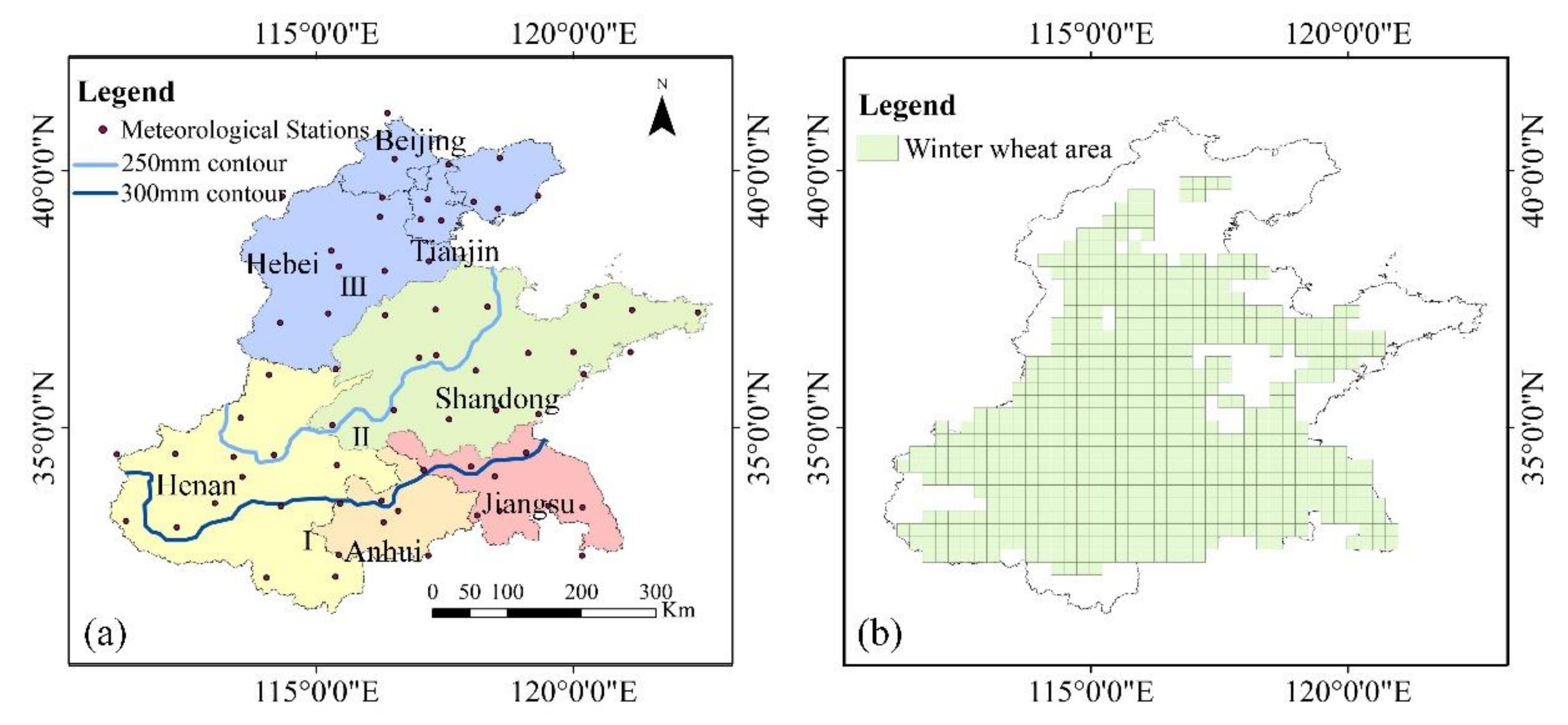
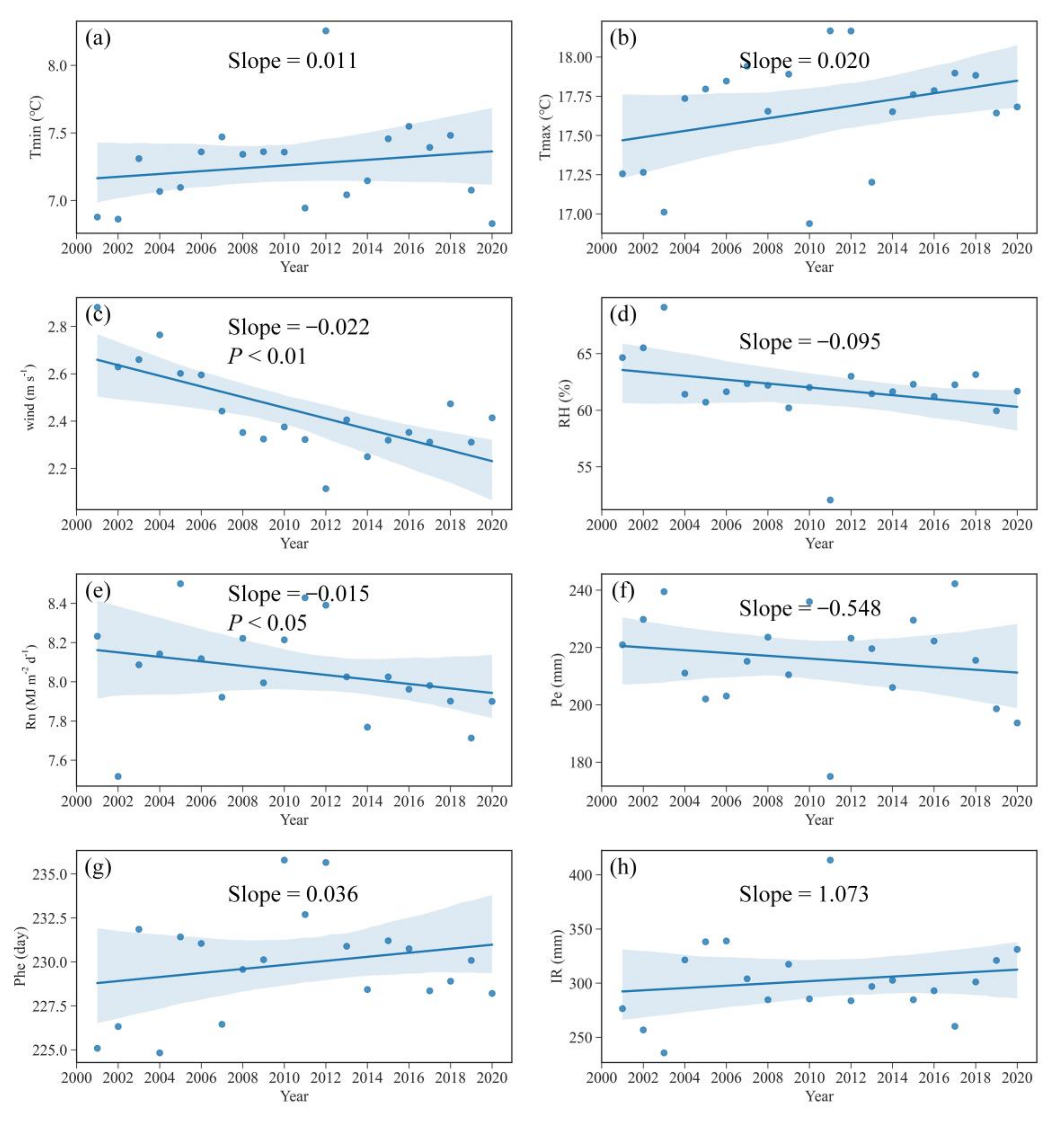
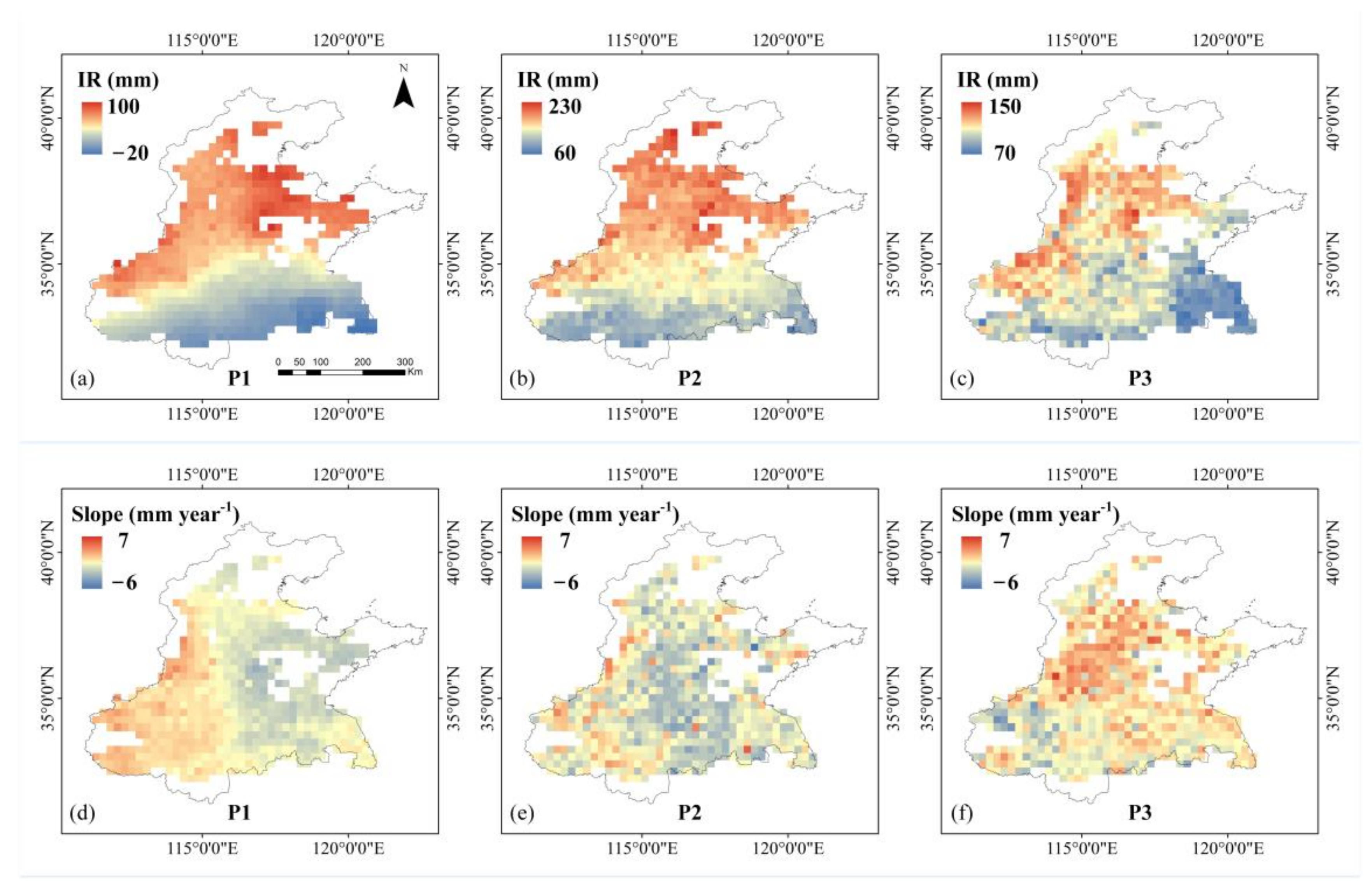

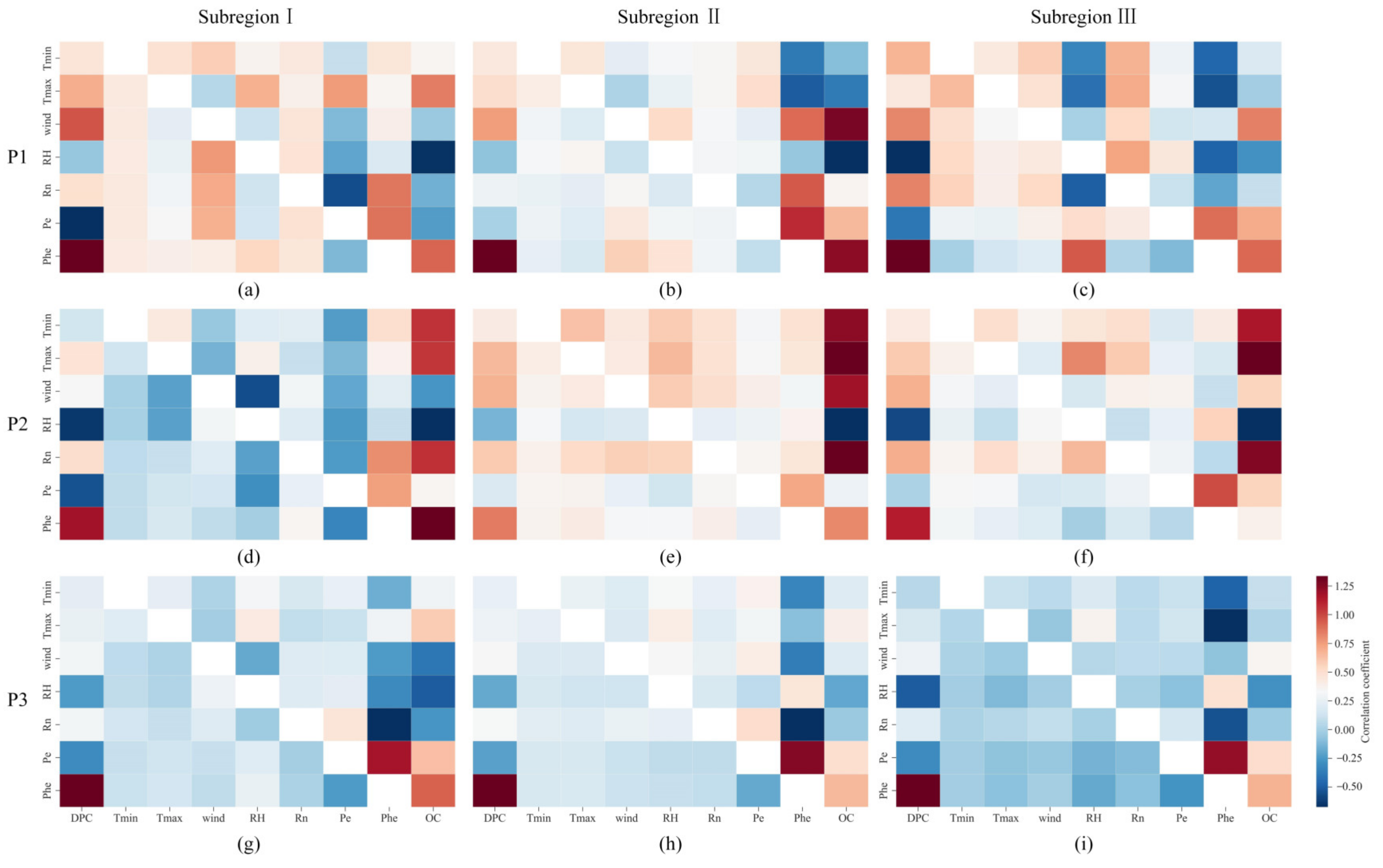
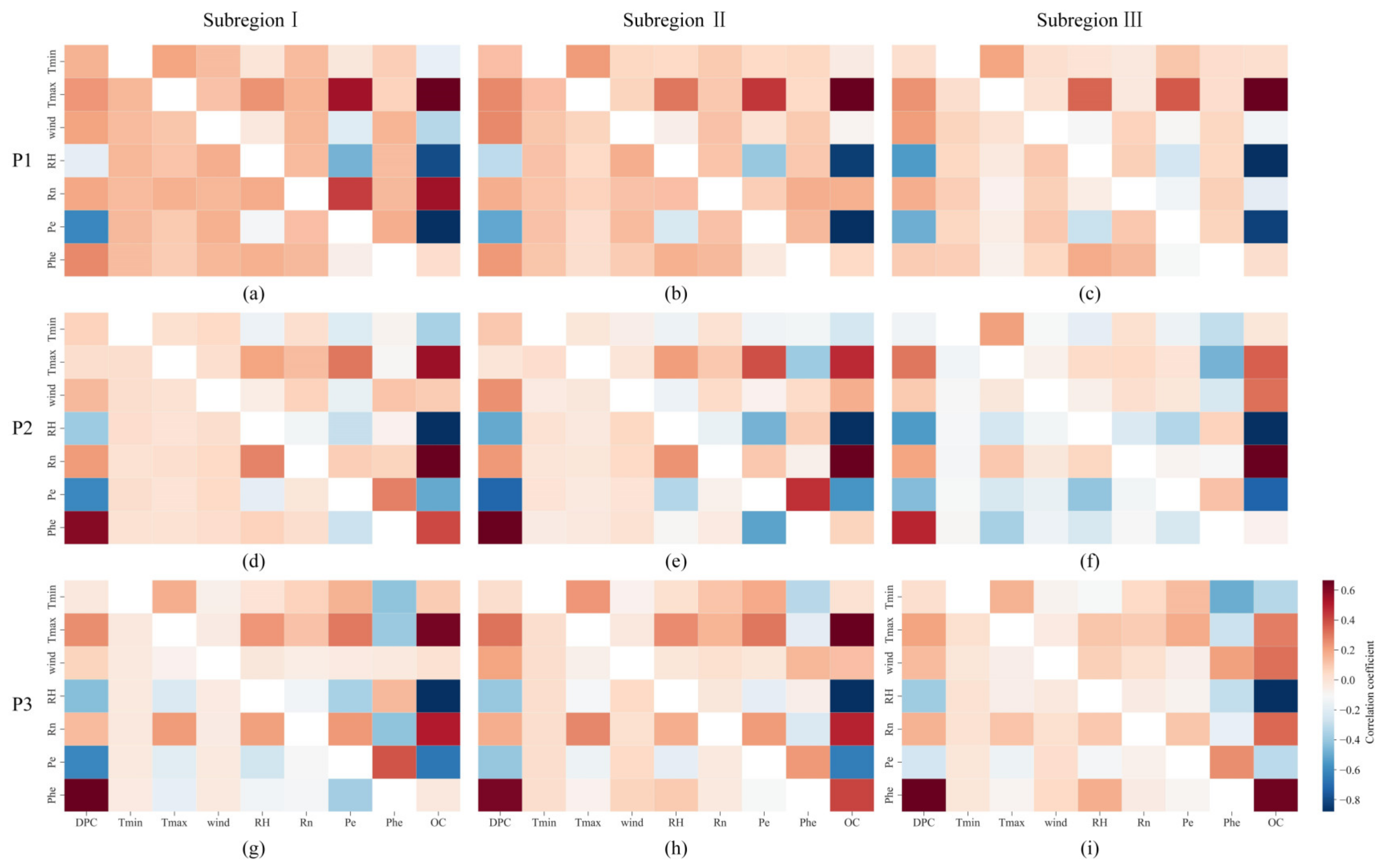

| Subregion I | Subregion II | Subregion III | |||||||
|---|---|---|---|---|---|---|---|---|---|
| Factors | P1 | P2 | P3 | P1 | P2 | P3 | P1 | P2 | P3 |
| Tmin | 0.217 ** | 0.209 ** | 0.408 ** | 0.486 ** | 0.222 ** | 0.282 ** | 0.587 ** | 0.381 ** | 0.260 ** |
| Tmax | 0.697 ** | 0.599 ** | 0.455 ** | 0.556 ** | 0.704 ** | 0.344 ** | 0.269 ** | 0.514 ** | 0.400 ** |
| wind | 0.887 ** | 0.537 ** | 0.694 ** | 0.905 ** | 0.885 ** | 0.695 ** | 0.941 ** | 0.841 ** | 0.797 ** |
| RH | −0.750 ** | −0.825 ** | −0.907 ** | −0.885 ** | −0.930 ** | −0.918 ** | −0.932 ** | −0.972 ** | −0.906 ** |
| Rn | 0.165 * | 0.778 ** | 0.702 ** | −0.157 * | 0.805 ** | 0.608 ** | 0.793 ** | 0.821 ** | 0.813 ** |
| Pe | −0.946 ** | −0.843 ** | −0.895 ** | −0.755 ** | −0.595 ** | −0.797 ** | −0.925 ** | −0.638 ** | −0.751 ** |
| Phe | 0.931 ** | 0.961 ** | 0.989 ** | 0.935 ** | 0.947 ** | 0.976 ** | 0.940 ** | 0.948 ** | 0.982 ** |
| Subregion I | Subregion II | Subregion III | |||||||
|---|---|---|---|---|---|---|---|---|---|
| Factors | P1 | P2 | P3 | P1 | P2 | P3 | P1 | P2 | P3 |
| Tmin | 0.136 | 0.328 | 0.042 | 0.053 | 0.480 | −0.006 | −0.089 | −0.128 | 0.080 |
| Tmax | 0.612 * | 0.106 | 0.674 ** | 0.539 * | 0.050 | 0.765 ** | 0.348 | 0.813 ** | 0.661 * |
| wind | 0.711 ** | 0.753 ** | 0.804 ** | 0.797 ** | 0.777 ** | 0.879 ** | 0.841 ** | 0.792 ** | 0.842 ** |
| RH | −0.924 ** | −0.888 ** | −0.939 ** | −0.910 ** | −0.753 ** | −0.966 ** | −0.886 ** | −0.879 ** | −0.964 ** |
| Rn | 0.651 * | 0.743 ** | 0.688 ** | 0.617 * | 0.738 ** | 0.772 ** | 0.552 * | 0.831 ** | 0.926 ** |
| Pe | −0.991 ** | −0.950 ** | −0.986 ** | −0.974 ** | −0.914 ** | −0.986 ** | −0.955 ** | −0.893 ** | −0.953 ** |
| Phe | 0.901 ** | 0.974 ** | 0.989 ** | 0.679 ** | 0.942 ** | 0.993 ** | 0.102 | 0.964 ** | 0.988 ** |
Publisher’s Note: MDPI stays neutral with regard to jurisdictional claims in published maps and institutional affiliations. |
© 2022 by the authors. Licensee MDPI, Basel, Switzerland. This article is an open access article distributed under the terms and conditions of the Creative Commons Attribution (CC BY) license (https://creativecommons.org/licenses/by/4.0/).
Share and Cite
Wang, N.; Wu, J.; Gu, Y.; Jiang, K.; Ma, X. Factors Influencing the Spatiotemporal Variability in the Irrigation Requirements of Winter Wheat in the North China Plain under Climate Change. Agronomy 2022, 12, 1987. https://doi.org/10.3390/agronomy12091987
Wang N, Wu J, Gu Y, Jiang K, Ma X. Factors Influencing the Spatiotemporal Variability in the Irrigation Requirements of Winter Wheat in the North China Plain under Climate Change. Agronomy. 2022; 12(9):1987. https://doi.org/10.3390/agronomy12091987
Chicago/Turabian StyleWang, Nan, Jiujiang Wu, Yuhui Gu, Kongtao Jiang, and Xiaoyi Ma. 2022. "Factors Influencing the Spatiotemporal Variability in the Irrigation Requirements of Winter Wheat in the North China Plain under Climate Change" Agronomy 12, no. 9: 1987. https://doi.org/10.3390/agronomy12091987
APA StyleWang, N., Wu, J., Gu, Y., Jiang, K., & Ma, X. (2022). Factors Influencing the Spatiotemporal Variability in the Irrigation Requirements of Winter Wheat in the North China Plain under Climate Change. Agronomy, 12(9), 1987. https://doi.org/10.3390/agronomy12091987






